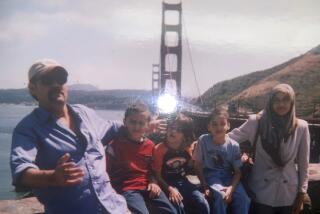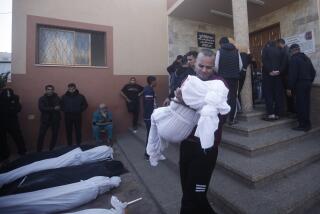U.S. casts a wide net in hostage hunt
- Share via
BAGHDAD — U.S. troops have detained hundreds of Iraqis, including four on the military’s wanted list, and dropped thousands of leaflets from airplanes, promising as much as $200,000 for help in recovering three American soldiers captured Saturday by suspected Islamic radicals, Army officers said Tuesday.
At least 460 people were held for questioning, although an undisclosed number have been released, the U.S. military said. About 4,000 U.S. troops continued to sweep the orchards and farmland around Mahmoudiya, 20 miles southwest of Baghdad.
“Literally hundreds have been picked up for questioning and after are released,” said U.S. Army Lt. Col. Randy Martin, spokesman for the military command policing Baghdad’s volatile southern belt, a sanctuary for armed Sunni Arab groups.
Eleven detainees have been identified as possessing valuable information, including the four suspected insurgents who had been sought before the ambush.
“We have conducted more than 460 tactical interviews and detained 11 individuals, four of them are considered high-value targets,” said U.S. military spokesman Army Lt. Col. Christopher Garver.
“High-value targets” is a U.S. military term for suspected leaders of militant groups, bomb makers, tacticians and other key insurgents. Garver said it was not clear whether the four were connected with Saturday’s ambush 12 miles west of Mahmoudiya, which killed four U.S. soldiers and their Iraqi army interpreter.
U.S. military officials say they believe the Islamic State of Iraq, a coalition of insurgent groups linked to Al Qaeda, is holding the soldiers. The coalition has claimed responsibility for the ambush and abductions.
“We pray they are still alive so we can return them to their loved ones,” Martin said of the soldiers.
*
Hide-outs targeted
U.S. troops, including Special Forces units, have conducted at least 10 major operations aimed at militant hide-outs in the search for the captives, Martin said.
Loudspeakers blared a message offering the $200,000 reward as Army vehicles rolled through the agrarian communities. The appeal also was broadcast on Iraqi radio.
U.S. soldiers have come under sporadic small-arms fire during their search in the region dubbed “the triangle of death” for the high number of kidnappings and killings of U.S. and Iraqi soldiers there. One American soldier was wounded in the skirmishes, Martin said.
Drones soared overhead and helicopters logged more than 255 hours of flight while other U.S. security agencies deployed in the area, Garver said.
A Sunni Muslim tribal leader, who identified himself as Sheik Abu Yasin, said the Americans were focusing on a Sunni Arab farming area called Harghawiya, between Mahmoudiya and Yousifiya.
“The Americans have been conducting raids and arrests for the past three days in this area. This is a Sunni area.... The search is very hard because of the nature of the orchards and farms,” Abu Yasin said.
The Army has yet to identify one of the four dead soldiers; the body was charred and the dog tags were missing. That left the military unsure of who was missing.
The other soldiers killed in the ambush were identified as Sgt. 1st Class James D. Connell Jr., 40, of Lake City, Tenn.; Pfc. Daniel W. Courneya, 19, of Nashville, Mich.; and Pfc. Christopher E. Murphy, 21, of Lynchburg, Va.
The four soldiers listed as “whereabouts unknown” include Pfc. Joseph J. Anzack Jr., 20, of Torrance. The others are Sgt. Anthony J. Schober, 23, of Reno, Nev.; Spc. Alex R. Jimenez, 25, of Lawrence, Mass.; and Pvt. Byron W. Fouty, 19, of Waterford, Mich.
All were with the 2nd Brigade Combat Team of the 10th Mountain Division, based in Ft. Drum, N.Y. They were in two armored Humvees looking for insurgents planting roadside bombs when their parked vehicles were struck by small-arms fire and explosives.
They were part of a larger team scattered along the road south of Baghdad, officials said.
*
Deployed 10 months ago
U.S. Army Lt. Col. Paul Fitzpatrick, a spokesman for the 10th Mountain Division, said at a news conference at Ft. Drum that the dead and missing soldiers were from the 4th Battalion, 31st Infantry Regiment and had been deployed in Iraq for 10 months.
Fitzpatrick said the military still hoped to rescue the soldiers, and called on their captors to treat them humanely.
“We expect any combatant opposing us to treat our soldiers with dignity and respect, but we cannot count on that with the violent extremism that we have seen with Iraqi insurgents,” he said.
The abductions came amid a U.S.-Iraqi military offensive that has seen at least 28,000 additional troops deployed in Baghdad and surrounding areas in a bid to crush both Sunni and Shiite Muslim extremists.
The new 20,000-strong command in south Baghdad was created at the beginning of April. The area is seen as a transit point into the capital for Sunni extremists carrying out car bombings and suicide attacks.
Last June, two U.S. troops were captured near Mahmoudiya and killed, an attack claimed by a group loyal to Al Qaeda. The executions came three months after the rape and killing of a 14-year-old girl and the slaying of her parents and 12-year-old sister in Mahmoudiya. Two U.S. soldiers have been convicted and three others are awaiting trial in those crimes.
Meanwhile, at least 14 people were killed Tuesday around the country, including seven in a roadside bombing near central Baghdad’s Shorja market, police said.
Fifteen bodies were found, all bearing gunshot wounds, police said. Four other bodies were discovered dumped in Baqubah, 35 miles northeast of Baghdad. All were presumed to be victims of sectarian death squads.
In other violence, a mortar shell landed inside Baghdad’s Green Zone, wounding five U.S. Embassy contractors, embassy spokesman Lou Fintor said.
*
julian.barnes@latimes.com
Parker reported from Baghdad and Barnes from Washington. Times staff writers Saif Hameed and Said Rifai in Baghdad and a special correspondent in Hillah contributed to this report.
More to Read
Sign up for Essential California
The most important California stories and recommendations in your inbox every morning.
You may occasionally receive promotional content from the Los Angeles Times.












